Sizing Up Servers: Intel's Skylake-SP Xeon versus AMD's EPYC 7000 - The Server CPU Battle of the Decade?
by Johan De Gelas & Ian Cutress on July 11, 2017 12:15 PM EST- Posted in
- CPUs
- AMD
- Intel
- Xeon
- Enterprise
- Skylake
- Zen
- Naples
- Skylake-SP
- EPYC
Intel’s Turbo Modes
A last minute detail from Intel yesterday was information on the Turbo modes. As expected, not all of the processors actually run at their rated/base frequency: most will apply a series of turbo modes depending on how many cores are registered as ‘active’. Each core can have its frequency adjusted independently, allowing VMs to take advantage of different workload types and not be hamstrung by occupants on other VMs in the same socket. This becomes important when AVX, AVX2 and AVX-512 are being used at the same time.
Most of the turbo modes are a sliding scale, with the peak turbo used when only one or two cores are active, sliding down to a minimum frequency that may be the ‘base’ frequency or just above it. There’s a lot of information for the parts here, so we’ll break it down into stages.
First up, a look at the Platinum 8180 in the different modes:
It should be worth noting what the base frequency actually is, and some of the nuance in Intel’s wording here. The base frequency is the guaranteed frequency of the chip – Intel sells the chip with the base frequencies as the guarantee, such that when the chip is not idle and not in normal conditions (i.e. when not in thermal power states to reduce temperature) should operate at this frequency or above it. Intel also lists the per-core turbo frequencies as ‘Maximum Core Frequencies’ indicating that the processors could be running lower than listed, depending on power distribution and requirements in other areas of the chip (such as the uncore, or memory controller). It’s a vague set of terms but ultimately the frequency is determined on the fly and can be affected by many factors, but Intel guarantees a certain amount and provides guides as to what it expects the turbo frequencies to be.
As for the Platinum 8180, it keeps its top turbo modes while up to two cores are active, and then drops down. It does this again for another two cores, and a further two cores. From this point, under non-AVX load the CPU is pretty much the same frequency until >20 cores are loaded, but does not decrease that much in all. For AVX 2.0 and AVX-512, the downward slope of more cores means less frequency continues, with AVX-512 taking a bigger jump down at 13 cores loaded. The final turbo frequency for AVX-512 running on all cores is 2.3 GHz.
Comparing the two 28-core CPUs for which we have turbo information gives this graph. The numbers relate to the number of cores need to be loaded for that frequency.
Both processors are equal to each other for dual core loading, but the separation occurs when more cores are loaded. As we move through to AVX 2.0 and AVX-512, it is clear where the separations are in performance – to get the best for variable core loading, the more expensive processors are required.
Here’s the big table for all the processors on Non-AVX loading:
Despite the 2.0/2.1 GHz base on most of the Platinum series, all the CPUs will turbo up to 3.7-3.8 GHz on low core loading except for the lower power Platinum 8153. For users wanting to strike a good balance between the core count and frequency, the Gold 6154 is probably the place to be: 18 cores that will only ever run at 3.7 GHz with non-AVX loading (3.5-2.7 GHz on AVX-512 depending on core count), and will be $3543 as a list price at 205W. It is perhaps worth noting that this will likely top any of the Core i9 processors planned: at 18-cores and 205W for 3.7 GHz, the Core i9-7980XE which will have 18 cores but run 165W will likely be clocked lower (but also only ~$2000).
Moving onto AVX2.0 and AVX-512:


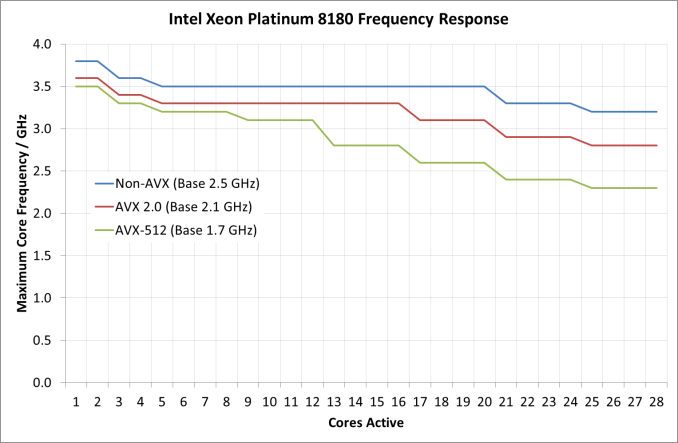
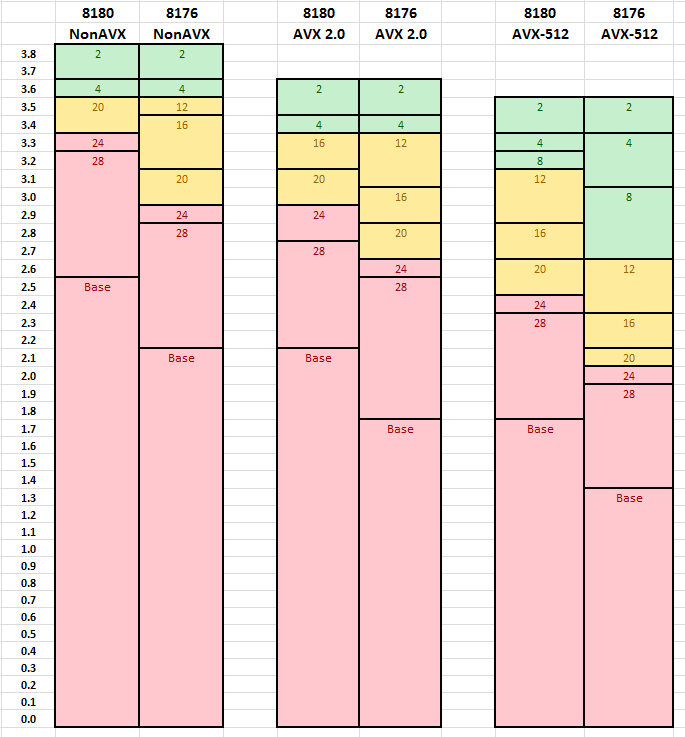
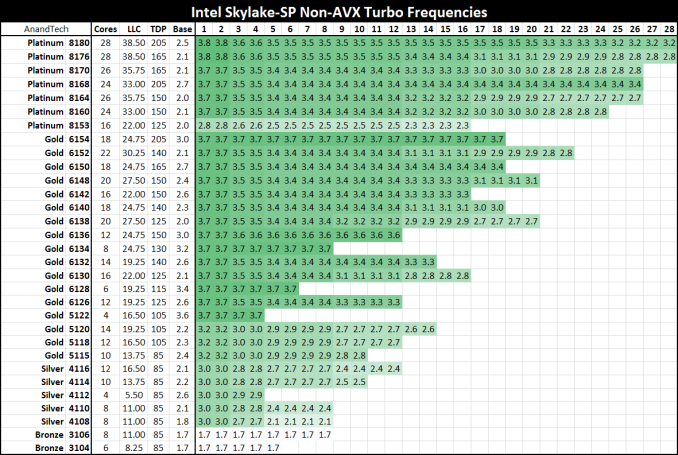
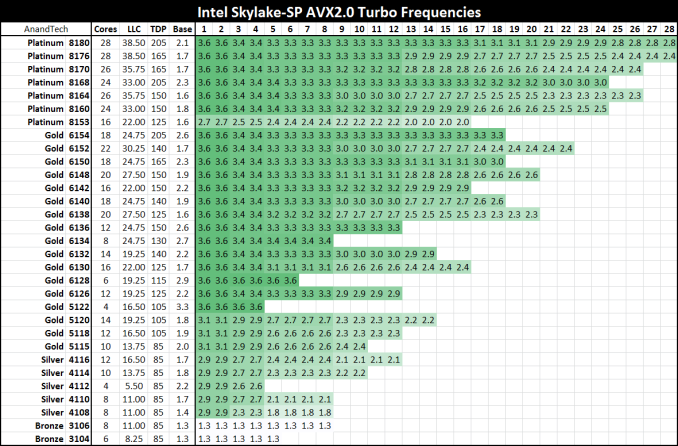
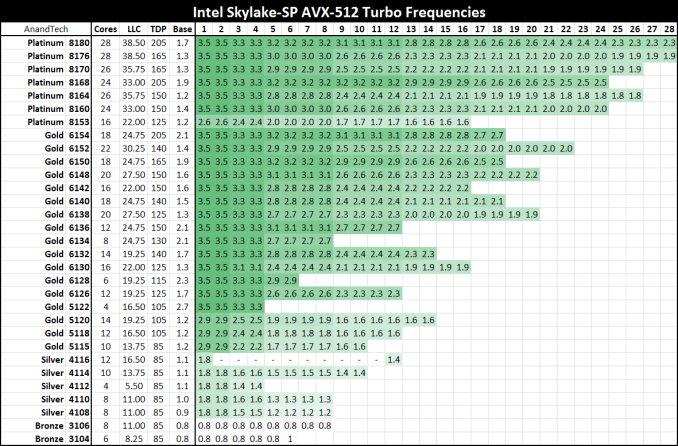








219 Comments
View All Comments
tamalero - Tuesday, July 11, 2017 - link
How is that different if AMD ran stuff that is extremely optimized for them?Friendly0Fire - Tuesday, July 11, 2017 - link
That's kinda the point? You want to benchmark the CPUs in optimal scenarios, since that's what you'd be looking at in practice. If one CPU's weakness is eliminated by using a more recent/tweaked compiler, then it's not a weakness.coder543 - Tuesday, July 11, 2017 - link
Rather, you want to test under practical scenarios. Very few people are going to be running 17.04 on production grade servers, they will run an LTS release, which in this case is 16.04.It would be good to have benchmarks from 17.04 as another point of comparison, but given how many things they didn't have time to do just using 16.04, I can understand why they didn't use 17.04.
Santoval - Wednesday, July 12, 2017 - link
A compromise can be found by upgrading Ubuntu 16.04's outdated kernel. Ubuntu LTS releases include support for rolling HWE Stacks, which is a simple meta package for installing newer kernels compiled, modified, tested and packaged by the Ubuntu Kernel Team, and installed directly from the official Ubuntu repositories (not via a Launchpad PPA). With HWE 16.04 LTS can install up to the kernel of 18.04 LTS.I also use 16.04 LTS + HWE (it just requires installing the linux-generic-hwe-16.04 package), which currently provides the 4.8 kernel. There is even a "beta" version of HWE (the same package plus an -edge at the end) for installing the 4.10 kernel (aka the kernel of 17.04) earlier, which will normally be released next month.
I just spotted various 4.10 kernel listings after checking in Synaptic, so they must have been added very recently. After that there are two more scheduled kernel upgrades, as is shown in the following link. Of course HWE upgrades solely the kernel, it does not upgrade any application or any of the user level parts to a more recent version of Ubuntu.
https://wiki.ubuntu.com/Kernel/RollingLTSEnablemen...
CajunArson - Tuesday, July 11, 2017 - link
Considering the similarities between RyZen and Haswell (that aren't coincidental at all) you are already seeing a highly optimized set of RyZen results.But I have no problem seeing RyZen be tested with the newest distros, the only difference being that even Ubuntu 16.04 already has most of the optimizations for RyZen baked in.
coder543 - Tuesday, July 11, 2017 - link
What similarities? They're extremely different architectures. I can't think of any obvious similarities. Between the CCX model, caches being totally different layouts, the infinity fabric, Intel having better AVX-256/512 stuff (IIRC), etc.I don't think 16.04 is naturally any more optimized for Ryzen than it is for Skylake-SP.
CajunArson - Tuesday, July 11, 2017 - link
Oh please, at the core level RyZen is a blatant copy-n-paste of Haswell with the only exception being they just omitted half the AVX hardware to make their lives easier.It's so obvious that if you followed any of the developer threads for people optimizing for RyZen they say to just use the Haswell compiler optimizations that actually work better than the official RyZen optimization flags.
ddriver - Tuesday, July 11, 2017 - link
Can't tell if this post is funny or sad.CajunArson - Tuesday, July 11, 2017 - link
It's neither: It's accurate.Don't believe me? Look at the differences in performance of the holy 1800X over multiple Linux distros ranging from pretty new (OpenSuse Tumbleweed) to pretty old (Fedora 23 from 2015): http://www.phoronix.com/scan.php?page=article&...
Nowhere near the variation that we see with Skylake X since Haswell was already a solved problem long before RyZen lauched.
coder543 - Tuesday, July 11, 2017 - link
Right, of course. Ryzen is a copy-and-paste of Haswell.Don't make me laugh.